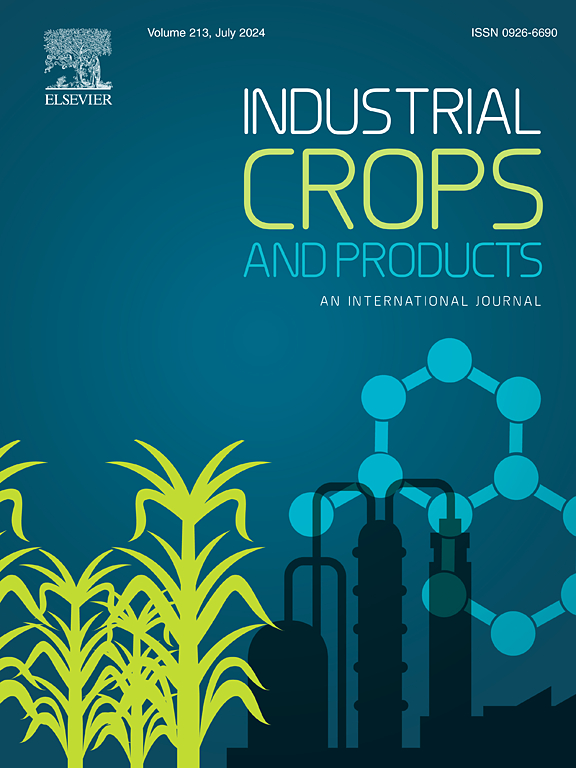Experimental study on the synergy between lignin and cellulose during co-torrefaction and its impact on the properties and structural characteristics of pyrolysis biochar
IF 5.6
1区 农林科学
Q1 AGRICULTURAL ENGINEERING
引用次数: 0
Abstract
This study aims to investigate the synergy between lignin and cellulose during co-torrefaction, as well as the influence of torrefaction temperature and mixing ratio on the basic properties and structural characteristics of the feedstocks and biochar. To this end, both single-component and co-torrefaction pretreatments with lignin and cellulose feedstocks were conducted at 220 ℃, 260 ℃, and 300 ℃, followed by pyrolysis at 550 ℃. The results showed that the torrefaction process led to increased fixed carbon and C content, lower volatiles and O content, and enhanced higher heating value (HHV). In addition, torrefaction decreased the crystallinity of cellulose while increasing that of lignin. For the co-torrefaction samples, crystallinity generally decreased after torrefaction, and this decrease was positively correlated with the cellulose ratio. Torrefaction also enhanced the degree of graphitization of the feedstocks through the removal of oxygen-containing functional groups. However, the elemental content and HHV of the biochar were largely unaffected. It was also found that lignin and cellulose exhibited synergy during co-torrefaction, which promoted the transition of feedstocks and biochar to higher carbon content and HHV while accelerating the removal of oxygen-containing functional groups. XPS analysis showed that under medium and high temperatures (260 ℃ and 300 ℃), co-torrefaction inhibited the decomposition of functional groups such as C-C, C![]() C, C-H, -OH, and C-O-C in the biochar, while promoting the decomposition of oxygen-containing functional groups such as C
C, C-H, -OH, and C-O-C in the biochar, while promoting the decomposition of oxygen-containing functional groups such as C![]() O, -COOH, and -COO. This study elucidates the notable role of co-torrefaction in improving the properties and pyrolysis performance of biomass components.
O, -COOH, and -COO. This study elucidates the notable role of co-torrefaction in improving the properties and pyrolysis performance of biomass components.
木质素和纤维素在共焙烧过程中的协同作用及其对热解生物炭性能和结构特征影响的实验研究
本研究旨在研究木质素和纤维素在共焙烧过程中的协同作用,以及焙烧温度和混合比例对原料和生物炭基本性质和结构特征的影响。为此,分别以木质素和纤维素为原料分别在220℃、260℃和300℃下进行单组分预处理和共焙烧预处理,然后在550℃下进行热解。结果表明:焙烧过程提高了固定碳和碳含量,降低了挥发物和O含量,提高了高热值(HHV);另外,焙烧降低了纤维素的结晶度,提高了木质素的结晶度。对于共焙烧样品,结晶度在焙烧后普遍下降,且结晶度的下降与纤维素比例呈正相关。焙烧还通过去除含氧官能团提高了原料的石墨化程度。然而,生物炭的元素含量和HHV在很大程度上不受影响。研究还发现,木质素和纤维素在共焙烧过程中表现出协同作用,促进了原料和生物炭向高碳含量和高HHV的过渡,同时加速了含氧官能团的去除。XPS分析表明,在中高温(260℃和300℃)下,共焙烧抑制了生物炭中C-C、CC、C-H、-OH、C-O-C等官能团的分解,促进了CO、-COOH、-COO等含氧官能团的分解。本研究阐明了共焙烧在改善生物质组分的性质和热解性能方面的显著作用。
本文章由计算机程序翻译,如有差异,请以英文原文为准。
求助全文
约1分钟内获得全文
求助全文
来源期刊

Industrial Crops and Products
农林科学-农业工程
CiteScore
9.50
自引率
8.50%
发文量
1518
审稿时长
43 days
期刊介绍:
Industrial Crops and Products is an International Journal publishing academic and industrial research on industrial (defined as non-food/non-feed) crops and products. Papers concern both crop-oriented and bio-based materials from crops-oriented research, and should be of interest to an international audience, hypothesis driven, and where comparisons are made statistics performed.
 求助内容:
求助内容: 应助结果提醒方式:
应助结果提醒方式:


